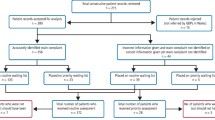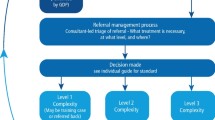Abstract
Aim The use of tier 2 practitioners has been suggested as an intermediate tier in the NHS workforce completing cases of moderate difficulty previously referred to secondary care. Provision of such services varies depending on speciality and local commissioning priorities. This service evaluation investigated reasons for and outcomes of endodontic referrals to an NHS tier 2 service in Powys, Wales.
Methods A sample of endodontic referrals was analysed with reasons for referral, referral outcome, requests for consultant support and patient demographic data recorded producing results with frequencies and percentage distributions.
Results Of 401 referrals evaluated, common reasons for referral were management of post-treatment disease (56.4%) followed by inability to locate or negotiate root canals (26.9%). Mandibular molar teeth were the most frequently referred. Additionally, 44.1% of patients referred went on to receive treatment. Consultant advice and/or treatment was required in the management of 3.5% of referrals, most frequently relating to referral of traumatic dental injuries, root resorption and immature apices.
Conclusions Results demonstrate tier 2 practitioners can effectively manage and treat the majority of NHS endodontic referrals. Remote consultant advice is effective in supporting tier 2 practitioners in the management of complex presentation, allowing effective treatment delivery.
Key points
-
The majority of NHS endodontic referrals relate to post-treatment disease.
-
Mandibular molar teeth were the most frequently referred for endodontic treatment.
-
Tier 2 dentists can effectively manage and treat the majority of NHS endodontic referrals.
This is a preview of subscription content, access via your institution
Access options
Subscribe to this journal
Receive 24 print issues and online access
$259.00 per year
only $10.79 per issue
Buy this article
- Purchase on Springer Link
- Instant access to full article PDF
Prices may be subject to local taxes which are calculated during checkout





Similar content being viewed by others
References
Health and Social Care Information Centre. Adult dental health survey 2009: summary report and thematic series. 2011. Available online at https://digital.nhs.uk/data-and-information/publications/statistical/adult-dental-health-survey/adult-dental-health-survey-2009-summary-report-and-thematic-series (accessed February 2021).
Cheung G, Lai S, Ng R. Fate of vital pulps beneath a metal-ceramic crown of a bridge retainer. Int Endod J 2005; 38: 521-530.
Saunders W, Saunders E. Prevalence of periradicular periodontitis associated with crowned teeth in an adult Scottish subpopulation. Br Dent J 1998; 185: E3.
Qualtrough A. Undergraduate endodontic education: what are the challenges? Br Dent J 2014; 216: 361-365.
Burke F, Samarawickram D. Progressive changes in the pulpo-dentinal complex and their clinical consequences. Gerodontology 1995; 12: 157-166.
Association of Consultants and Specialists in Restorative Dentistry. Role of consultants and specialists in restorative dentistry. 2012. Available at https://www.rcseng.ac.uk/-/media/files/rcs/fds/careers/jcptd/roleconsspecrest.pdf (accessed February 2021).
Morris A, Burke F. Primary and secondary dental care, how ideal is the interface? Br Dent J 2001; 191: 666-667.
Fairbrother K, Nohl F. Perceptions of general dental practitioners of a local secondary care service in restorative dentistry. Br Dent J 2000; 188: 99-102.
Sharpe G, Durham J, Preshaw P. Attitudes regarding specialist referrals in periodontics. Br Dent J 2007; 202: E11.
Tickle M, Milsom K, Qualtrough A, Blinkhorn F, Aggarwal V. The failure rate of NHS funded-molar endodontic treatment delivered in general dental practice. Br Dent J 2008; 204: E8.
De Moor R, Hulsmann M, Kirkevang J, Tanalp J, Whitworth J. Undergraduate Curriculum Guidelines for Endodontology. Int Endod J 2013; 46: 1105-1114.
Nixon P, Benson R. Referral rates to specialists from general practice. Br Dent J 2005; 199: 161-163.
Association of Consultants and Specialists in Restorative Dentistry. What is Restorative Dentistry? Available at http://www.restdent.org.uk/about-us/restorative-dentistry/ (accessed September 2017).
NHS Commissioning Board. Securing excellence in commissioning NHS dental services. 2013. Available at https://www.england.nhs.uk/wp-content/uploads/2013/02/commissioning-dental.pdf (accessed February 2021).
Drake S. Introducing dentists with special interests (DwSI) - past, present and future perspectives. Prim Dent Care 2005; 12: 20-22.
Alani A, Bishop K. Contemporary issues in the provision of restorative dentistry. Br Dent J 2012; 213: 163-170.
O'Neill E, Gallagher J, Kendall N. A baseline audit of referral and treatment delivered to patients in the intermediate minor oral surgery service in Croydon PCT. Prim Dent Care 2012; 19: 23-28.
Al-Haboubi M, Eliyas S, Briggs P, Jones E, Rayan R, Gallagher J. Dentists with extended skills: the challenge of innovation. Br Dent J 2014; 217: E6.
Ghotane S, Al-Haboubi M, Kendall N, Robertson C, Gallagher J. Dentists with enhanced skills (Special Interest) in Endodontics: gatekeepers views in London. BMC Oral Health 2015; 15: 110.
Eliyas S, Briggs P, Gallagher J. The experience of dentists who gained enhanced skills in endodontics within a novel pilot training programme. Br Dent J 2017; 222: 269-275.
Rooney E. The evolution of dentists with enhanced skills. Faculty Dent J 2015; 6: 66-70.
NHS England. Accreditation of performers and provides of level 2 complexity care. 2018. Available online at https://www.england.nhs.uk/publication/guidance-for-commissioners-on-the-accreditation-of-performers-of-level-2-complexity-care/ (accessed October 2018).
Nuttall N, Steed M, Donachie M. Referral for secondary restorative care in rural and urban areas of Scotland: findings from the Highlands and Islands Teledentistry Project. Br Dent J 2002; 192: 224-228.
Dummer P. The quality of root canal treatment provided by general dental practitioners working within the general dental services in England and Wales. Dent Profile 1998; 19: 8-10.
Brocklehurst P, Tickle M, Birch S, Glenny A, Mertz E, Grytten J. The effect of different methods of remuneration on the behaviour of primary car dentists. Cochrane Database Syst Rev 2013; DOI: 10.1002/14651858.CD009853.pub2.
Davies B, MacFarlane F. Clinical decision making by dentists working in the NHS General Dental Services since April 2006. Br Dent J 2010; 209: E17.
Whitworth J, Seccombe G, Shoker K, Steele J. Use of rubber dam and irrigant selection in UK general practice. Int Endod J 2000; 33: 435-441.
Abbott P. Analysis of a referral-based endodontic practice: Part 1. Demographic data and reasons for referral. J Endod 1994; 20: 93-96.
Kim S. Prevalence of referral reasons and clinical symptoms for endodontic referrals. Restor Dent Endod 2014; 39: 210-214.
Ng Y, Mann V, Gulabivala K. Outcome of secondary root canal treatment: a systematic review of the literature. Int Endod J 2008; 41: 1026-1046.
Su Y, Wang C, Ye L. Healing rate and post obturation pain of single versus multiple endodontic treatment for infected root canals: a systematic review. J Endod 2011; 37: 125-132.
Krasner P, Rankow H. Anatomy of the pulp-chamber floor. J Endod 2004; 30: 5-16.
Kim J, Alapati S, Knoernschild K, Jeong Y-H, Kim D, Lee D. Micro-computerised tomography of tooth volume changes following post removal. J Prosthod 2017; 26: 522-528.
Torabinejad M, Nasrat A, Verma P, Udochukwu O. Regenerative endodontic treatment or mineral trioxide aggregate apical plug in teeth with necrotic pulps and open apices: A systematic review and meta-analysis. J Endod 2017; 43: 1806-1820.
Ellis S, Ashley M, Deans R. A survey of referrals to restorative dentistry department in a district general hospital. Eur J Prosthod Restor Dent 2001; 9: 59-66.
Johns B, Brown L, Nash K, Warren M. The endodontic workforce. J Endod 2006; 32: 838-846.
Author information
Authors and Affiliations
Corresponding author
Rights and permissions
About this article
Cite this article
Thomas, G., Newton, R., Tolley, W. et al. Novel tier 2 service model for complex NHS endodontics. Br Dent J (2021). https://doi.org/10.1038/s41415-021-2840-3
Received:
Accepted:
Published:
DOI: https://doi.org/10.1038/s41415-021-2840-3
This article is cited by
-
Oral surgery wait times in NHS secondary dental care in England: a five-year review
British Dental Journal (2022)



